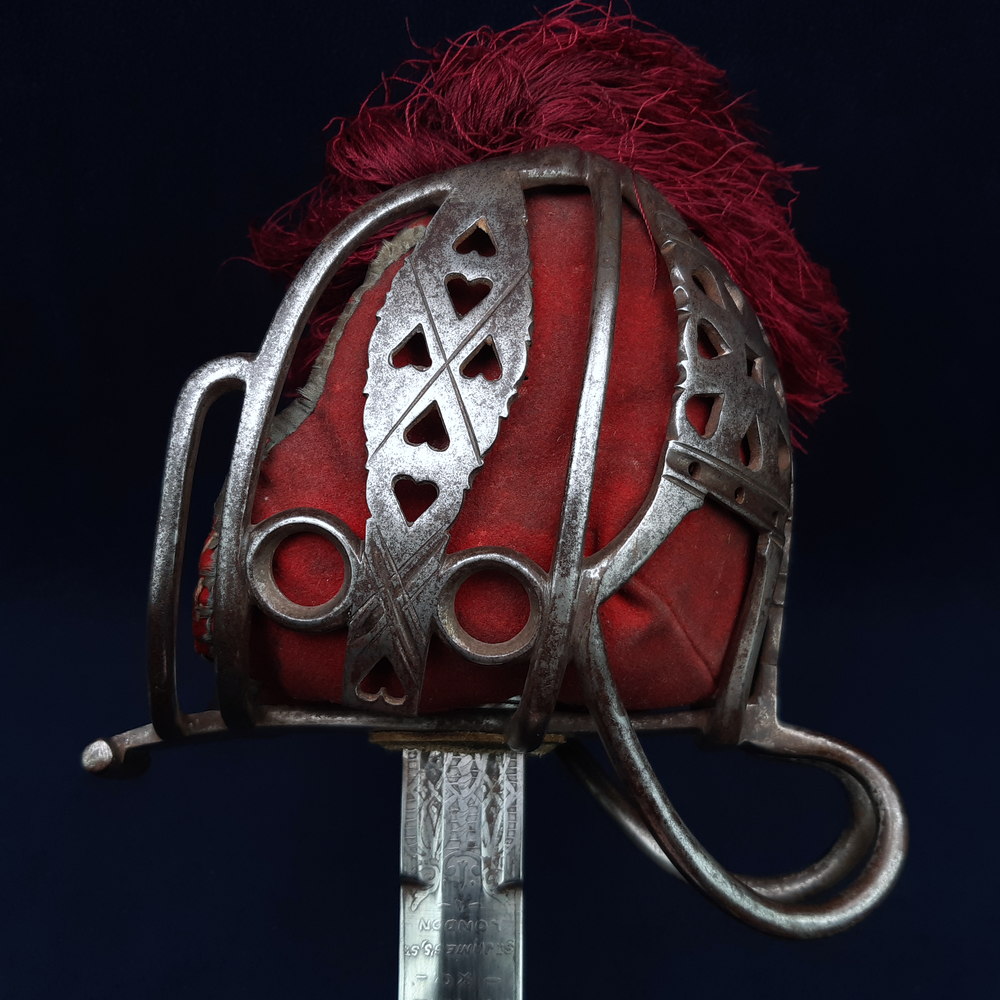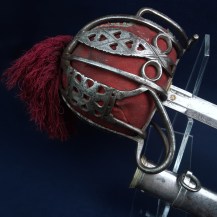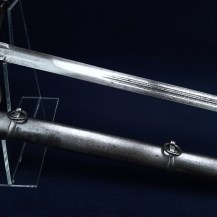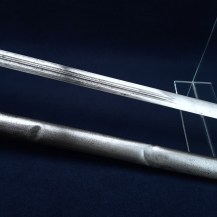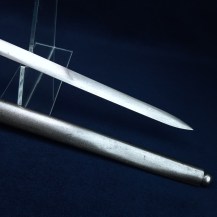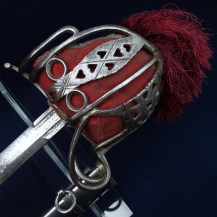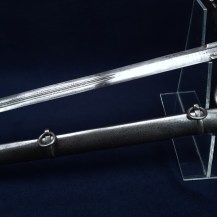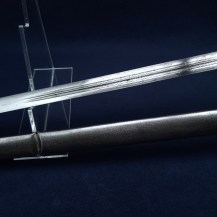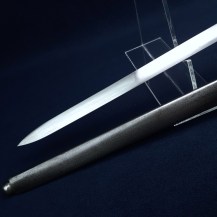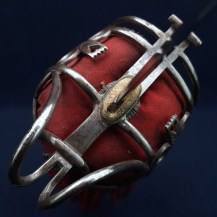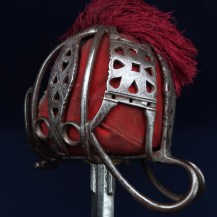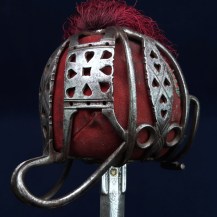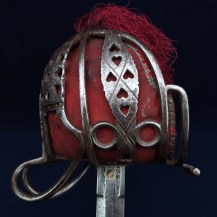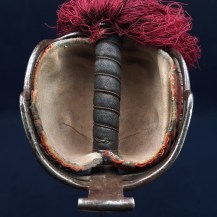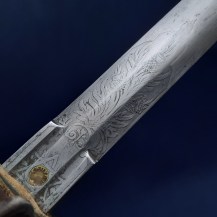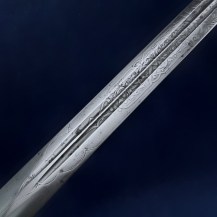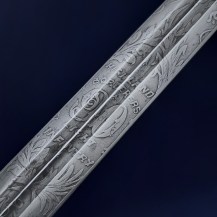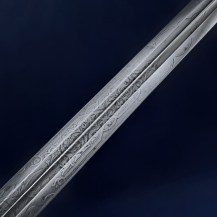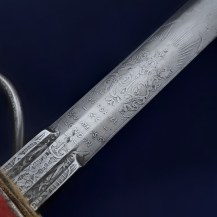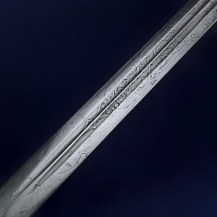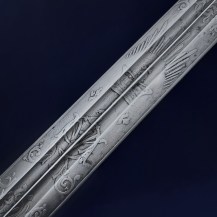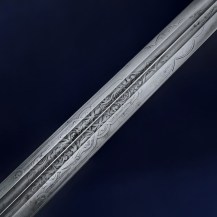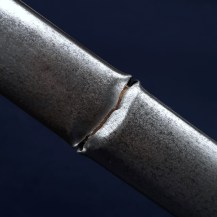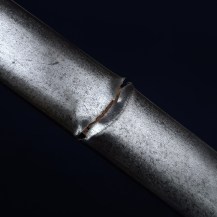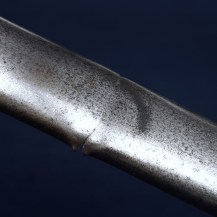Scottish Victorian 1828 Pattern Infantry Officer’s Basket Hilt Broadsword, 90th Highland Borderers Light Infantry, 1855-1881
Straight spear-pointed blade with double central fullers and two short fullers at the ricasso. Steel pierced basket hilt, brown leather washer, red fabric hilt liner with white leather inner and blue silk edging. Spiral grip of wood covered with shagreen bound with wire, steel ferrule and pommel cap, fringe of red silk thread. Steel scabbard with two hanging rings, ball chape finial. Blade 34¼ inches in length past the washer, the sword 40½ inches overall.
On one side at the ricasso is a brass proof slug reading ‘PROVED’, set within an etched six-pointed star. The blade is further etched on that side with ‘HIGHLAND BORDERERS 90 LIGHT INFANTRY’, wreaths of laurel and palm and foliate motifs. It is etched on the other side with the retailer’s mark ‘MARSHALL & CO ST JAMES’S ST LONDON’ beneath the royal coat of arms, as well as the crown and cypher of Queen Victoria and foliate motifs. Marshall & Co. was a retailer who like many military outfitters resold swords made elsewhere, with their name applied to the blade at the production stage – the Wilkinson company records, for instance, list Marshall as one of their trade customers.
The 5th or Fifeshire Regiment of North British Militia was one of many created by the Militia Act of 1797 – this essentially replicated the long-standing English militia system that had existed since 1757, but which had not previously applied to Scotland. Parish constables drew up lists of all men aged 18 – 50, with limited exemptions, then drew ballots to select some for three years of compulsory militia service, although men chosen could delegate their role to paid substitutes if they could find & afford them.
Militia units were for home defence only, and could not be sent overseas – service in practice meant a few weeks of training each year and occasional mustering for duty in keeping public order, almost always outside their home county. Nonetheless, the compulsory system was unpopular and riots had broken out in Lincolnshire in 1757 over the first Act, some wrongly believing that it meant they would be conscripted into fighting overseas. Even forty years later some Scots feared at first that men in the militia would be ordered out of Scotland against their will.
The Fifeshire Regiment recruited from the counties of Fife, Stirling, Clackmannan and Kinross until 1803, when it replaced Fife with Dumbarton, becoming the 28th Stirling, Dumbarton, Clackmannan, and Kinross Militia, sometimes referred to just as the Stirling Militia or Stirlingshire Militia. Recruitment was relatively strong compared to some counties, but not exactly eager: in 1808 only five of the 222 men from Stirling were principals (men actually chosen in the ballot) while the rest were all paid substitutes.
The regiment languished for a long period, called out for training only 4 times between 1816 and 1855, until the Militia (Scotland) Act of 1854 breathed new life into it, reworking the Stirling Militia into the 90th Highland Borderers Light Infantry Militia, with the Duke of Montrose as their honorary Colonel.
The Childers Reforms of 1881 attached volunteer and militia regiments to their local regular infantry regiments as new battalions – the 90th therefore became the 3rd Battalion of the Argyll and Sutherland Highlanders. That means this sword can be dated to the period 1855-1881.
The 3rd Battalion served in South Africa during the Boer War – a memorial can be seen in the Church of the Holy Rude in Stirling which commemorates the 13 men of the battalion that died there.
During WW1 the 3rd Battalion served as a training unit, it was a Supplementary Reserve unit in WW2. It was ultimately disbanded in 1953.
The traditionally-styled Scottish broadsword was carried exclusively by Highland infantry regiments until 1881, when the Lowland regiments adopted Scottish dress and the broadsword along with it (with the exception of the Cameronians aka Scottish Rifles). This example does not have an interchangeable hilt, it is peened permanently in place. Interchangeable hilts are a feature that dates back to the 1860s and were first officially mentioned in the Dress Regulations of 1883. This would normally be a helpful feature for dating but it should be noted that Scottish volunteer and militia swords are typically non-interchangeable even in later periods.
The blade is bright with only a few small spots of patination, some of these among the etching. Its edge is unsharpened and undamaged. The shagreen of the grip is all intact with very light handling wear, its wire binding is all present and tight. The sword is solid in the hand with only very fractional movement of the ferrule.
The, hilt, ferrule and pommel have some mottled patination. The fringe is very good with good colour and strength to the strands. The hilt liner has some light staining in places, its blue edging has been almost entirely lost exposing the join between fabric and leather.
The scabbard has speckled light patination and one spot of notable damage – a deep dent on one side which has rent the steel, exposing the wood core and meaning that the scabbard is supported there only by the remaining strip of steel on the opposite side, which flexes due to the weight of the scabbard. Too much bending there could put pressure on the wood core, so take care to support the scabbard when the blade is withdrawn. One small dent elsewhere on the opposite side. Despite this damage the sword still fully sheaths and draws.

